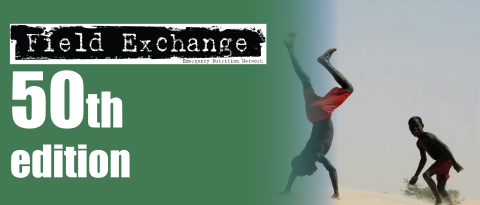Summary of Field Exchange user survey findings

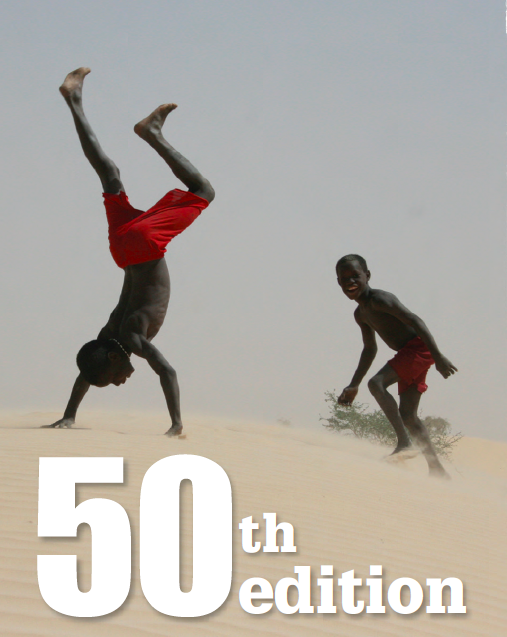
The ENN extends thanks to Alex Bycroft Masters student, at Oxford Brookes University, UK who undertook a Field Exchange citations review, included in this summary, on a voluntary basis.
An online user survey of Field Exchange (FEX) was carried out between March and May 2015. A request to participate in the survey was sent to FEX readers by email and on the ENN website, with a link to the survey online. There were a total of 138 respondents to the survey. Overall, 91% of respondents were satisfied or very satisfied with FEX. More detailed findings of the survey are as follows.
Nearly half of respondents were based in Africa, just over a quarter in North America and Europe and 20% in Asia (see Figure 1). Most respondents worked in nutrition (66%), emergency nutrition (33%), infant and young child feeding (38%) and health (30%) sectors;1 A minority worked in water, sanitation and hygiene (WASH) (3.6%), agriculture (3.6%) and cash (2%) programming. Of 119 respondents, 38% were working with international non-governmental organisations (NGOs), 15% government, 13% academic institutions and 6% local NGOs. Others were independent consultants/self-employed (12%), students (5%) or were working with civil society (1.7%) or private sector (6.7%).
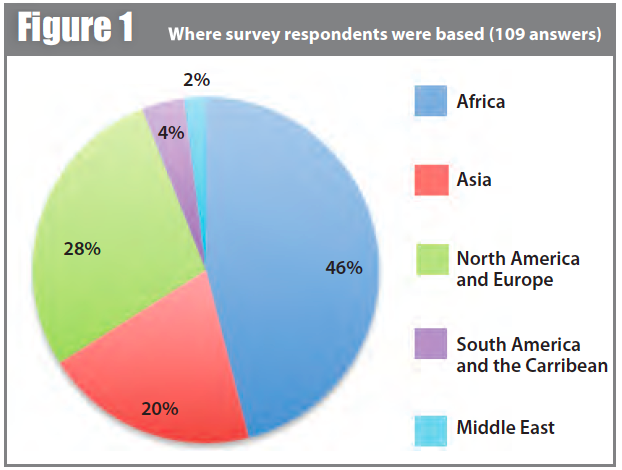
FEX was read for personal learning and updating knowledge by 82% of respondents and to keep up to date with research by 50%. The respondents reflected an established readership, with 60% having read FEX for three or more years (see Figure 2). Topics that respondents reported learning most about (113 answers) were infant and young child feeding (28%), community based management of acute malnutrition (CMAM) (26%), emergency nutrition (20%), survey/coverage methodology (10%) and cash programming (9%).
Most respondents (73%) said that there are no topics, programmes or contexts missing from FEX. Of those that said that there were areas missing (27%), there were a wide range of suggestions including nutrition and HIV, transition from emergency to development programming, nutrition sensitive agriculture, stunting prevention and nutrition and advocacy.
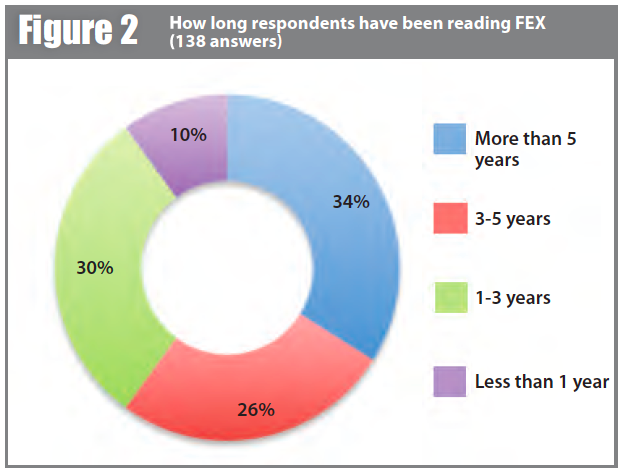
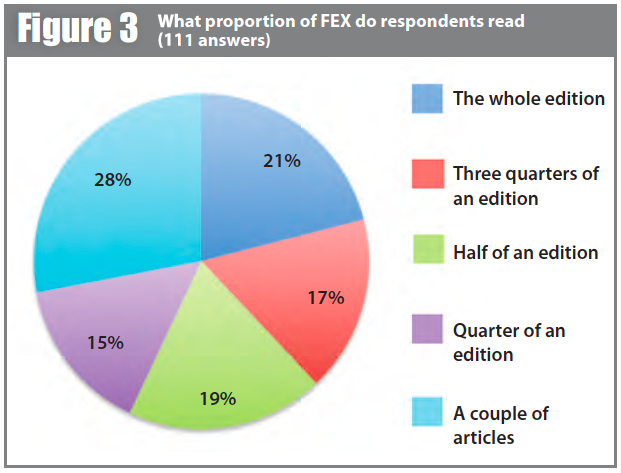
In terms of the usefulness of each of the different types of articles in FEX, respondents rated field articles as the most useful, followed by research, evaluations, news, views and editorials; agency profiles were rated as the least useful. Seventy-four percent of respondents (of 110 answers) felt that the length of FEX is ‘just right’ while 83% were happy with the current frequency (three times per year). In terms of the level of technical detail of FEX editions, most respondents (78%) said it was just right, whilst 15% said it was too detailed and 7% not detailed enough. FEX editions can have either mixed content or be thematic. When asked which they prefer (of 110 answers), 47% reported that they prefer mixed editions, 46% found both equally valuable and 7% preferred thematic editions.
An important question related to print or online content; 65% (of 110 respondents) were satisfied with the online facility and 25% were very satisfied with it. Respondents were asked within which formats they read FEX; 78% reported reading FEX in print; 28% read individual articles online and 23% read the whole issue online. Of those that did not read articles online, 70% said it was because they prefer print copies and 22% said they had limited/too costly/no online access. It is interesting to see that, in this digital age, print copies of FEX remain valuable and useful to our audience. It is also important to note that this online survey will be biased towards those with accessible internet access.
Respondents reported that FEX has had a ‘good’ or ‘large’ impact on their organisation or work in a number of ways: information knowledge (82%), information awareness (76%), transfer of knowledge/strengthened intellectual capacity (65%), networking with others (51%), and collaboration with others (45%). Furthermore, 67% reported that they had applied FEX sourced evidence in field practice, while 46% reported that content had influenced strategy and policy. An additional average of 29% respondents reported ‘some’ impact.
“Through FEX I learn from other agencies experience in dealing with field level challenges in similar contexts and adopt a similar approach for successful programming.” Employee of an international NGO
“FEX provides evidence-based practice that we would otherwise miss.” Employee of an African-based academic institution
Of 110 respondents, 15% reported having ever contributed an article for FEX. Of these, the majority (89%) said that they received adequate support from the editorial team. Sixty-three percent of respondents said that they have recommended others to share their work through FEX. When asked the reason for not writing an article (91 respondents), 43% were unsure of the process and nearly one quarter of respondents were unsure regarding the value of their experience to others (see Figure 4).
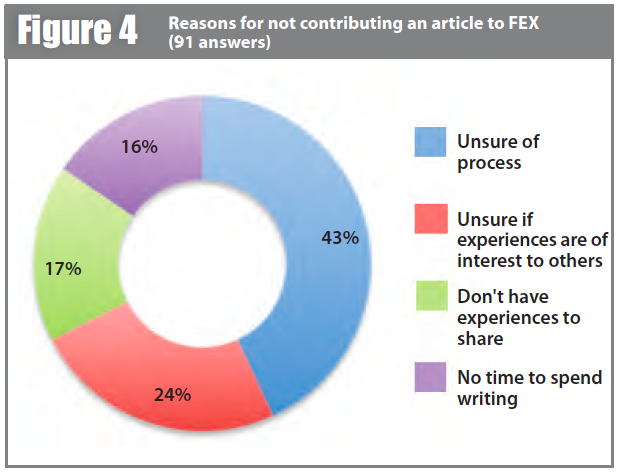
Most respondents valued the “public good” nature of FEX; 55% of respondents (of 109 answers) felt that FEX should be free to all, while 39% felt it should be free to those working in lower income countries and only 6% of respondents said it should be paid for by subscription.
Most (90%) of respondents reported that they are satisfied with the way in which the ENN communicates with them about FEX. When asked in which format they would like to receive information from the ENN, 80% of respondents said they would like to receive information by email, 60% via FEX, 34% via the ENN website, 14% via Face book and 6% via Twitter
Citations review
To complement the user survey, from April to June 2015 the ENN undertook a review to explore how the ENN produced resources are cited and used in the development of a range of external publications. The review was conducted on a voluntary basis by a Masters student.
This study found that, between Jan 2010 and June 2015, 62 works (articles, publications or reviews) produced by the ENN were cited 128 times in 93 journals, reports and theses. ENN peer-reviewed articles were the most frequently cited (10 articles cited 55 times), followed by field articles (34 articles cited 44 times), write-ups of ENN research and reviews (nine write ups cited 17 times) and FEX news and views pieces (three articles cited four times).
ENN authored works have been cited most commonly in peer-reviewed journals, as well as in organisational reports and academic theses. The peer-reviewed journals within which the ENN works were cited were wide-ranging and influential publications (including The Lancet medical journal) and mostly focused on nutrition, food and health topics.
The topics/themes of the ENN works most frequently cited (in order of the most frequent) were malnutrition in infants less than six months; the double burden of malnutrition; CMAM; supplementary feeding; aid effectiveness; infant and young child feeding; cash programming; and wasting and stunting.
This small review indicates that the ENN publications are both well-read and well regarded by academics and peers, and have been used to contribute to the evidence base of effective nutrition and food security research, policy and programming.
ENN response
The number of field articles per edition has more than doubled in recent years meaning the edition has inevitably grown in size; we have questioned amongst ourselves whether it may be too big for our readers to digest but this seems not to be case.
We will continue to publish a variety of innovative programme experiences and research on the key topics that are important to people (e.g. IYCF, CMAM, coverage and cash) and will consider the suggestions made by respondents for new topics. Some of these suggested topics are already planned for inclusion in upcoming issues; FEX 51 will be a thematic issue on nutrition-sensitive programming. Stunting (and linkages with wasting) is a key area of ENN research interest; we will be opening a stunting thematic discussion area on ENNs online forum, en-net, in the near future.
Other actions that we will take stemming from this feedback include;
- Developing a guide on how to write an article that will include an outline of the support the editorial team can offer. This is included in FEX 50 and is also available online at www.ennonline.net/fex.
- Our recent online versions of FEX have been produced in A4 format to facilitate easier home printing and online viewing; this will continue.
- We have included agency profiles in FEX since the publication began, but perhaps this survey shows that they are less relevant for our current audience with field articles and research more valued by readers. We will consider discontinuing agency profiles.
Overall we are delighted that our readers appear to be satisfied with FEX. We will strive to continue to publish articles that are interesting and useful to our audience and that will ultimately have a positive impact on their work and the sector as a whole. We will continue to fund raise to ensure that we sustain our model of free access to print and online content for all. We sincerely thank all those who took part in the survey.
Feedback on FEX is welcome at any time. Send your observations and suggestions to: Marie McGrath, Co-editor
Footnotes
1More than one response possible.


